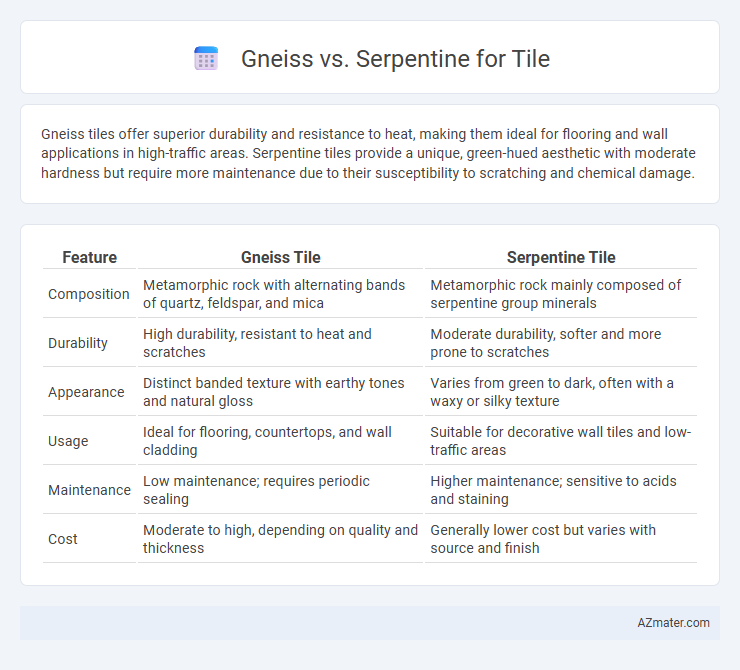Gneiss tiles offer superior durability and resistance to heat, making them ideal for flooring and wall applications in high-traffic areas. Serpentine tiles provide a unique, green-hued aesthetic with moderate hardness but require more maintenance due to their susceptibility to scratching and chemical damage.
Table of Comparison
| Feature | Gneiss Tile | Serpentine Tile |
|---|---|---|
| Composition | Metamorphic rock with alternating bands of quartz, feldspar, and mica | Metamorphic rock mainly composed of serpentine group minerals |
| Durability | High durability, resistant to heat and scratches | Moderate durability, softer and more prone to scratches |
| Appearance | Distinct banded texture with earthy tones and natural gloss | Varies from green to dark, often with a waxy or silky texture |
| Usage | Ideal for flooring, countertops, and wall cladding | Suitable for decorative wall tiles and low-traffic areas |
| Maintenance | Low maintenance; requires periodic sealing | Higher maintenance; sensitive to acids and staining |
| Cost | Moderate to high, depending on quality and thickness | Generally lower cost but varies with source and finish |
Introduction to Gneiss and Serpentine Tiles
Gneiss tiles are prized for their durability and unique banded texture formed by high-temperature and high-pressure metamorphic processes, making them ideal for both indoor and outdoor applications. Serpentine tiles, derived from serpentinized ultramafic rock, offer a distinctive greenish color palette and a smooth, often glossy surface, favored for decorative interiors and wet areas due to their resistance to moisture. Selecting between gneiss and serpentine tiles depends on desired aesthetic appeal and functional requirements, with gneiss suited for rugged wear and serpentine valued for its elegance and coloration.
Geological Origins: Gneiss vs Serpentine
Gneiss is a metamorphic rock formed from high-grade regional metamorphism of igneous or sedimentary rocks, characterized by its banded texture resulting from the recrystallization of minerals under intense heat and pressure. Serpentine, on the other hand, originates from the alteration of ultramafic rocks such as peridotite, undergoing hydration and low-grade metamorphism that produces its distinctive greenish hues and smooth, often waxy surface. These geological origins influence the durability and aesthetic qualities of gneiss and serpentine tiles, affecting their suitability for various architectural applications.
Physical Appearance and Color Variations
Gneiss tiles exhibit a distinct banded appearance with alternating light and dark layers, showcasing a coarse-grained texture that enhances their natural elegance. Serpentine tiles feature a smooth, often waxy luster with color variations ranging from deep greens to lighter olive and yellowish hues, offering a unique and earthy aesthetic. The contrasting color palettes and textures of gneiss and serpentine provide diverse options for interior design, with gneiss emphasizing bold patterns and serpentine highlighting rich, uniform tones.
Durability and Hardness Comparison
Gneiss exhibits higher durability and hardness than serpentine, making it more resistant to scratches and wear in tile applications. With a Mohs hardness rating typically around 6 to 7, gneiss surpasses serpentine, which generally ranges between 3 and 5. This increased hardness allows gneiss tiles to better withstand heavy foot traffic and maintain their structural integrity over time.
Porosity and Water Resistance
Gneiss exhibits low porosity and excellent water resistance, making it highly suitable for tile applications in wet areas such as bathrooms and kitchens. Serpentine, while visually appealing with its unique patterns, has higher porosity and lower water resistance, requiring sealing treatments to prevent water damage and staining. Choosing gneiss over serpentine ensures greater durability and minimal moisture absorption in high-traffic, moisture-prone environments.
Suitability for Interior and Exterior Use
Gneiss is a durable and dense metamorphic rock with excellent resistance to weathering, making it suitable for both interior flooring and exterior cladding in various climates. Serpentine, softer and more porous, is typically favored for interior applications such as bathroom walls and decorative surfaces due to its susceptibility to staining and weathering outdoors. For exterior use, gneiss offers superior longevity and low maintenance, while serpentine's aesthetic appeal is best preserved in controlled indoor environments.
Maintenance and Cleaning Requirements
Gneiss tiles offer excellent durability with minimal maintenance, requiring only regular sweeping and occasional damp mopping to keep their natural tones vibrant. Serpentine tiles, composed mainly of magnesium silicate, demand more careful care to prevent staining and etching, necessitating pH-neutral cleaners and periodic sealing to maintain their polished finish. Both materials benefit from prompt spill cleanup, but serpentine's softer composition makes it more susceptible to scratches and acid damage compared to the harder, more resilient gneiss.
Slip Resistance and Safety Features
Gneiss tiles offer moderate slip resistance due to their coarse grain texture, making them suitable for areas where safety is crucial but heavy moisture exposure is limited. Serpentine tiles provide higher slip resistance because of their naturally rough, uneven surface, enhancing safety in wet or high-traffic environments. Both materials are durable, but serpentine's enhanced traction makes it the preferred choice for slip-resistant flooring solutions.
Environmental Impact and Sourcing
Gneiss and serpentine tiles differ significantly in environmental impact and sourcing. Gneiss, a metamorphic rock frequently quarried in regions like India and Brazil, typically involves less energy-intensive extraction and processing compared to serpentine, which is often mined from ultramafic rock formations and may require careful handling due to potential asbestos content. The sourcing of gneiss tends to have a lower ecological footprint, with more widespread availability reducing transportation emissions, whereas serpentine's limited geographic distribution can increase environmental costs related to extraction and shipping.
Cost and Availability Analysis
Gneiss tiles typically cost more due to their durability and aesthetic appeal, with prices ranging from $10 to $30 per square foot depending on the quality and finish. Serpentine tiles are generally less expensive, pricing between $5 and $15 per square foot, but may vary significantly based on regional availability and extraction costs. Gneiss is more widely available in the market, especially in regions with abundant granite and schist formations, while serpentine's availability is limited by its more localized geological deposits, potentially increasing transportation costs.

Infographic: Gneiss vs Serpentine for Tile
 azmater.com
azmater.com